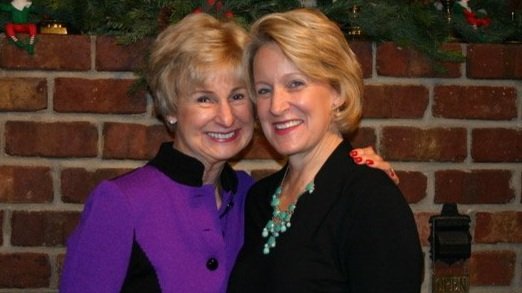The Power of a Dime
A Mother-Daughter Journey of Philanthropy and Community Impact
Philanthropic commitment stems from a generational legacy for founding members Alicia Salisbury, a Kansas state senator from 1985 to 2000, and her daughter, Margaret LaRue, a longtime community advocate and volunteer.
Alicia Salisbury and Margaret LaRue
As a child, Salisbury emulated her parents’ giving ways by putting a dime taken from her weekly allowance into a March of Dimes change card to help eradicate polio.
“I didn’t get much for my allowance, but I felt like I’d made a difference whenever I put a dime in the slot and filled my cards up,” she said. “My mom and dad were happy to give to community causes and giving made me happy too.”
She used her March of Dimes example to recruit others to The Women’s Fund.
Salisbury said she was told early in life that women make most of a family’s financial decisions, including how a household’s charitable funds are allocated.
“That made great sense to me, and it’s been so gratifying to see young people coming in to support The Women’s Fund,” she said. “I absolutely love it.”
LaRue was active with the Junior League and The Topeka Community Foundation when she became the youngest founding member of The Women’s Fund in her mid-30s.
“The Topeka Community Foundation had been talking about the power of the purse and introduced the concept of a giving circle where women could influence community outcomes, and I was drawn to that,” she said. “I was raising a family and didn’t see that I had a lot of excess money to give but I realized I could be part of this effort to bring people together.”
LaRue said her participation in The Women’s Fund shaped how she wanted to make a difference in her hometown.
“We looked at our time, talent and treasure to determine how we could make the most significant impact as a family,” she said. “Children and education were a primary focus for me and the education piece was part of The Women’s Fund’s mission to educate the next generation of philanthropists.”
LaRue had an affinity for The Women’s Fund’s “I Give University” initiative, which “brought parents and kids together to talk about what being a philanthropist means and to think about how you want to create change. My two daughters, Brooke and Catherine, helped with the two-hour Saturday sessions we sponsored while they were in high school and that shared activity had an impact on them and on me too.”
She helped review grant proposals and served as a board member for The Women’s Fund and then her involvement gradually decreased as she established a foundation for Topeka West High School and got involved with Kansas Children’s Service League, CASA of Shawnee County and other nonprofits.
“Although my activity decreased, my interest in The Women’s Fund didn’t,” said LaRue, who still provides financial support to the organization and attends the annual luncheon when she can. “It’s been gratifying to see the next generation of philanthropists keep The Women’s Fund going as we intended. It’s grown and flourished as others see the important difference they can make through their participation.”
For others interested in joining The Women’s Fund, Salisbury said, “You don’t have to be wealthy. You just have to have a little money you’re willing to share with others in a meaningful way.”

